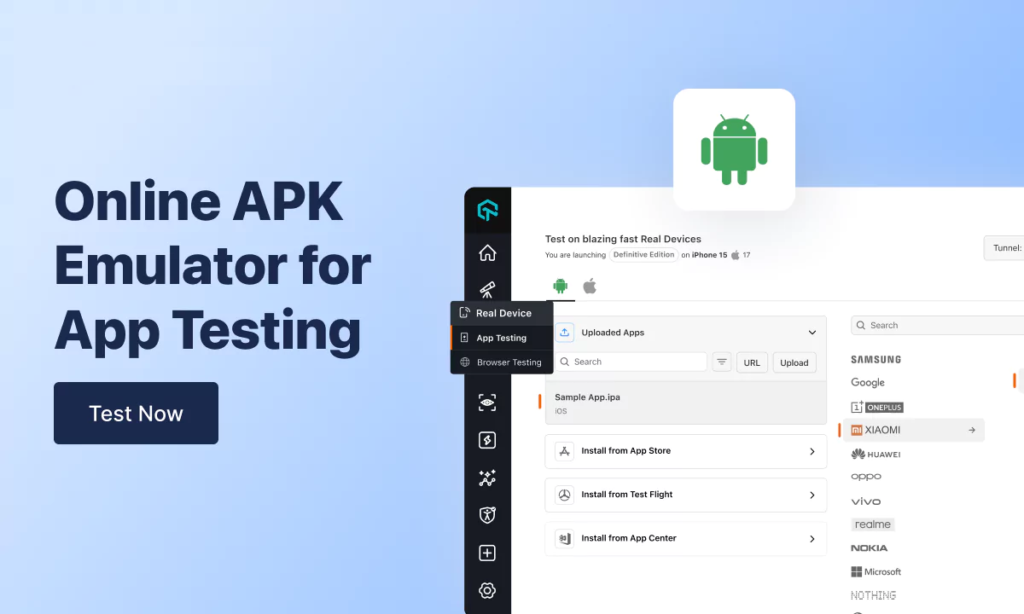A Comprehensive Guide To Test APK Files on an Emulator
How to Test APK Files on an Emulator is a fundamental stage for app developers and testers. APK (Android Bundle Pack) files address the organization Android uses to circulate and introduce apps. Before sending off an app, testing it in a controlled environment assists with distinguishing likely bugs, accidents, and performance issues. Emulators give a virtual stage that mirrors genuine Android gadgets. They permit developers to test their apps without requiring a genuine gadget.
We’ll investigate how to test APK files on an emulator. We’ll cover all that from setting up an emulator to running tests successfully. We should plunge into the means expected to ensure your APK works perfectly on different Android gadgets.

Setting Up the Emulator
The initial step is to introduce and set up an Android emulator. Android Studio, the authority-coordinated development environment (IDE) from Google, gives an inherent emulator. This emulator duplicates the Android working framework and different gadget models, permitting you to test apps proficiently.
Download and Install Android Studio:
To begin, you want to download Android Studio. Go to the authority Android Studio site and adhere to the installation instructions for your working framework (Windows, macOS, or Linux). Android Studio accompanies a strong emulator, making it the ideal decision for testing APK files.
Set Up Android Virtual Device (AVD)
Once Android Studio is introduced, the following stage is setting up an Android Virtual Gadget (AVD). This is a reenacted Android gadget with explicit screen sizes, Slam, and Android versions. You can configure it to impersonate different phones or tablets. To set up an AVD:
- Open Android Studio.
- Explore Tools > AVD Manager.
- Click on Make Virtual Gadget.
- Pick a gadget model and an Android version.
- Change the configuration (e.g., resolution, Slam) to match your ideal testing situation.
- Click Finish to make the AVD.
Launch the Emulator:
After making an AVD, send off it by tapping the Play button in the AVD Manager. The emulator will boot up, showing the virtual Android gadget’s home screen. This interaction could require a couple of moments, contingent upon your framework’s performance.
More Queries: How to Increase Battery Life on Android
Installing APK Files on the Emulator
Now that your emulator is running, now is the ideal time to introduce the APK document. There are multiple ways of doing this, including utilizing the Android Studio interface or through command-line tools.
Installing Using Android Studio:
The simplest method is through Android Studio. Follow these steps:
- Open your venture in Android Studio or make another task.
- Select the emulator as the objective gadget.
- Click on the Run button (green triangle) at the top of the Android Studio window.
- Android Studio will arrange your task, create an APK, and introduce it on the emulator.
If you’re not dealing with a venture, but rather have an APK record prepared for testing, you can move the APK straightforwardly onto the emulator window. The emulator will automatically introduce the APK, and you can begin utilizing it.
Installing Using ADB (Android Debug Bridge)
ADB is a flexible command-line tool that assists developers with speaking with Android gadgets. You can likewise utilize it to introduce APK files on an emulator. This is how it’s done:
- Open a terminal or command prompt.
- Navigate to the directory where the APK file is stored.
- Run the following command:
adb install yourapp.apk
- Replace “yourapp.apk” with the actual file name of the APK.
Once the installation is complete, the app will appear in the emulator’s app drawer, ready for testing.
Running Tests on the Emulator
After installing the APK, now is the right time to begin testing. You’ll have to zero in on different parts of your app, like functionality, performance, and UI responsiveness. The emulator gives tools to make testing more productive.
Functionality Testing:
The basic role of testing is to ensure that the app fills in as expected. This includes looking at all buttons, menus, and highlights to confirm they proceed true to form. To do this:
- Open the app on the emulator.
- Navigate through the app’s different sections.
- Test buttons, links, and input fields.
- Check if the app crashes or behaves unexpectedly during use.
Remember to test every feature of the app, including forms, navigation, and media elements.
Performance Testing:
Performance is another basic factor while testing APK files. The emulator allows you to monitor how the app acts under various situations, for example, low memory or slow organization conditions. You can reproduce these conditions in the emulator settings:
- Go to Settings > Device > Advanced in the emulator.
- Adjust network speed to simulate different internet conditions.
- Reduce the device’s memory to test the app’s behavior in low-RAM environments.
See how the app responds. Does it stack rapidly? Does it crash when assets are restricted? These experiences are fundamental for improving app performance.
UI/UX Testing:
User experience (UX) is similarly basically as important as functionality and performance. The emulator allows you to test the app’s UI across different screen sizes and resolutions. Check how well the app scales on various gadgets, guaranteeing that text, buttons, and pictures remain appropriately adjusted.
- Create multiple AVDs with different screen sizes (small, medium, large).
- Run the app on each AVD.
- Test UI elements such as menus, buttons, and fonts for consistency.
UI testing ensures your app looks professional and user-friendly on all devices.

Debugging the APK on an Emulator
Testing is unfinished without investigation. Troubleshooting distinguishes the underlying driver of accidents, errors, and bugs. Android Studio comes furnished with a strong investigating tool, permitting you to follow issues while testing.
Using Android Studio Debugger:
To debug an APK file, follow these steps:
- Open your undertaking in Android Studio.
- Set breakpoints in the code where you suspect an issue might emerge.
- Click the Troubleshoot button rather than Rush to begin the investigating system.
- The emulator will send off the app in troubleshoot mode, permitting you to monitor code execution, variable qualities, and possible exceptions.
Debugging gives you detailed insights into what’s happening behind the scenes, helping you pinpoint and fix errors.
Using Logcat for Error Tracking:
Logcat is another helpful tool that records framework messages, including blunders and stack follows, created by your app. To view Logcat:
- Open Android Studio.
- Navigate to View > Tool Windows > Logcat.
- Filter the output by your app’s package name to view relevant logs.
Logcat helps you track down issues such as crashes, slow performance, or incorrect behaviors during testing.
Additional Tools for Testing APK Files on an Emulator
While Android Studio is a complete tool for testing APK files, other valuable tools can additionally enhance your testing interaction.
Genymotion:
Genymotion is an outsider Android emulator that offers an extensive variety of gadget configurations. It’s quicker than the default Android Studio emulator and gives an easy-to-use interface. Genymotion incorporates Android Studio and ADB, permitting consistent APK testing.
Firebase Test Lab:
Firebase Test Lab is a cloud-based testing stage. It allows you to test your APK on different genuine and virtual Android gadgets. While an emulator imitates gadgets, Firebase utilizes genuine equipment, giving you more exact test results.
By incorporating Firebase Test Lab with Android Studio, you can automate testing across various gadget models, saving time and guaranteeing a more extensive similarity test for your app.
Conclusion
How to Test APK Files on an Emulator Download is a critical cycle in app development. It allows developers to recognize bugs, evaluate performance, and ensure similarity across various gadgets. Android Studio’s emulator, joined with tools like ADB, Logcat, and Genymotion, gives a strong testing environment. Additionally, utilizing Firebase Test Lab can work on the dependability of your tests.




